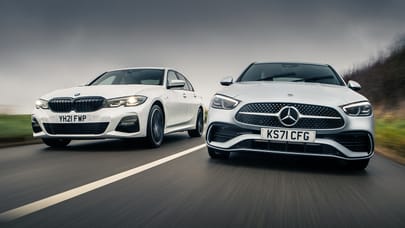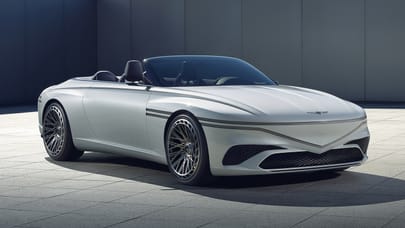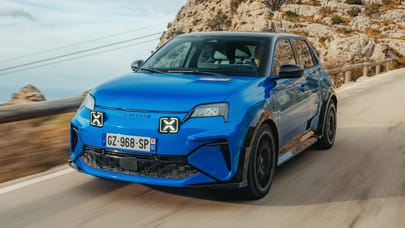

It may look like a retro amalgam of Buckminster Fuller’s 1933 Dymaxion car and the 1937 Audi Streamliner, but it’s capable of 313mpg and VW is deadly serious about its latest super economy car, to the extent that it’s going to build it for sale in two years’ time.
Words: Andrew English
Photos: Ingo BarenscheeThis feature was originally published in the March issue of Top Gear magazine
Advertisement - Page continues below
Can Wolfsburg be serious? Listen to chairman Martin Winterkorn, and you can take it to the bank. "To meet the EU targets of limiting global warming to just 2°C by 2050," he says, "then the average fuel consumption of the world's car fleet will need to be about 313mpg by then." Er, I hate to tell you this, but VW's XL1 launched at the inaugural Qatar motor show in Doha at the end of January, might just be the supercar your children's children lust after.
So will you want one? We snatched a drive around the emirate's capital, where a consequence of the highest GDP in the world means these are the most exclusive traffic jams outside of Monaco on race week.

It is a gorgeous-looking thing. Just 389cm long and 118cm tall, the XL1 has a carbon-fibre reinforced polymer (CFRP) monocoque body and it weighs about the same as an original Mark 1 Golf. Wheel spats, scissor doors and television cameras (pictured) instead of wing mirrors help create an impression of something designed by Gerry Anderson for Thunderbirds. Aluminium subframes absorb crash forces, and it even has F1-style wheel claws so the wheels absorb crash stresses rather than fall off.
Advertisement - Page continues below
In the back, there's what amounts to half a 1.6-litre VW TDI turbodiesel engine, but made entirely of aluminium. This 800cc parallel twin clatters out a diminutive 47bhp, augmented by a plug-in hybrid system consisting of a thin 27bhp electric motor/starter that sits between the engine and the seven-speed twin-clutch transmission. Drive is to the rear wheels, and the range, with a full battery and a brimmed 2.2-gallon fuel tank, is about 340 miles. Top speed is limited to 99mph, with 0-62mph acceleration in 11.9secs, EU combined economy of 313mpg and CO2 emissions of 24g/km.

The battery is a Sanyo lithium-ion unit rated at 5kWh, with enough punch to drive on volts alone for 22 miles at moderate throttle openings and speeds under 62mph. Weight and energy-saving ideas predominate. There's electrical aircon, lightweight wiring with electrical fuses, low-friction plasma-sprayed surfaces on the engine bores and pistons and LED lamps including the headlights. When it comes to saving fuel, this is the guvnor.
While the designers didn’t get much of a chance to stylise the exterior, in the cabin, they were dealt a freer hand. It’s lovely, clean and easy to use, but also innovative. Unlike this car’s tandem-seat antecedents, the seats are mounted side by side, but staggered so you don’t clash shoulders. The passenger’s seat is fixed, but the driver’s adjusts along with the steering wheel to give a pretty good driving position for up to six-footers.

"We wanted it to be recognisably a VW, but also to show how different it was," says British designer Andrew Hart-Barron. He's achieved it, with a clever mix of VW Group instruments, a feature-length piano-black ventilation duct and matt, carbon-fibre black background that looks and feels like velvet.
Like a Lamborghini's scissor doors, the VW's take a good tug to get shut, and there's an eerie silence as 22 gimlet-eyed mechanics and engineers look at you in their one-and-only £2 million prototype. Start-up involves a couple of prods of a button, but no engine noise. In hybrid mode, the car runs on battery power down to 22 per cent charge level, so around town it's silent.

Or it should be, but those narrow Michelins make a fair bit of noise, as does the whirring driveline. The ride is pretty rigid at low speeds, too, so the first impression is of trundling slowly out into the traffic and just waiting to be T-boned by a gold-encrusted SUV.
It does get better. Out on the dual carriageway, the ride improves, and you leave the transmission noise behind. Mash the throttle, and the engine starts, which thumps through the oily bits but transforms the performance. Suddenly this is a major-league fun car, with the electric torque wafting you along and the seven-speed gearbox managing to extract the last drop of performance. Those skinny tyres transmit a steady stream of feedback, and the unassisted steering is better than anything else in the Volkswagen Group.
Advertisement - Page continues below
What's surprising is how fast the XL1 will run on just its battery power. VW says it needs about half the energy to maintain 62mph as a 1.6-litre TDI Golf, itself a very frugal car.
Fun? Yes. Frugal? Certainly. By the end of a day's test driving, the fuel gauge had barely moved. But this 21st-century streamliner will have a highly limited audience. VW can't build more than 6,000 bodies a year, and XL1's technology is rarefied and expensive. Expect a price in excess of £30k, but we'll see a lot of the innovations creeping into other cars soon. This year's Up! Space microcar will use the XL1's twin-cylinder diesel hybrid powertrain to cut its CO2 emissions to the low 70s, LED lamps are already on their way and the carbon construction will be seen on this year's Lamborghini Aventador supercar.

This is Dr Piëch's project. The head of VW's supervisory board commissioned it when he was chairman of the firm and in 2002, after he'd driven that original One Litre car from his office in Wolfsburg to the shareholder's meeting in Hamburg, I drove it. That 290kg car was a prototype; noisy, raw, capable of 300mpg and charming. The second gen of the idea appeared at the 2009 Frankfurt show and now, with its rough edges smoothed, this XL1 demonstrates just how far you can travel on a gallon while still having fun. I thought it was fantastic, and I reckon the rest of the world will too.
Advertisement - Page continues below
Trending this week
- Electric
Top Gear's top 20 electric cars









